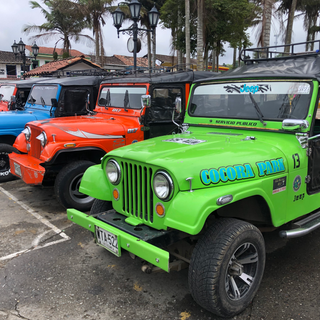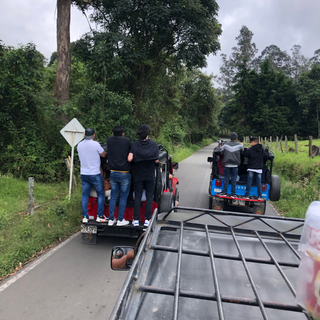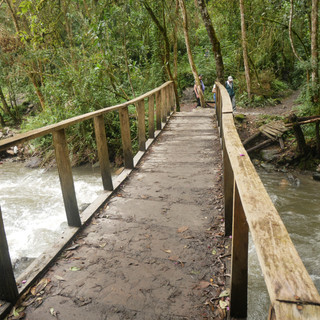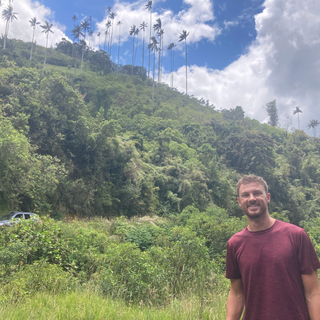Colombia's Coffee Region
- Nicole Behm
- Mar 29, 2022
- 11 min read
Long post alert: We love coffee, we love the great outdoors, and we love Colombia so this post (like so many others), definitely runs a bit long. The pictures are pretty epic, though, so you can scroll through them to get the basic idea :)
First of all, we want to thank John and Staci once again for coming to visit us in Cartagena. It was truly a great experience, and we had a blast. It was humbling that they would decide to use their limited time off to see us, but that made the experience all the more special. And thanks again to John for the blog post, we laughed quite a bit as we went back through the stories!
After John and Staci left, we still had a couple of additional days in Cartagena. As we had already experienced the pools, the sunsets, the beaches/boats, and a good amount of the food, we we sort of at a loss as to how to spend our time. We had some planning to catch up on (we still didn't know where we were staying that night or going after Cartagena!). After finding a place to stay that night we decided to maximize our remaining resort time, so we dropped off our bags at luggage storage at the hotel, used the gym, and hit the pools for the rest of the day (including more ceviche and a few beers). In the evening, we loaded up and went to our new place...which was (as expected), a bit of a let down from the Hilton. We had a room at a hostel that, we guess, wasn't quite ready for visitors. Yes, it had a bed, but it had no other furniture (or closet space, or even hooks to hang things) so we had to just leave our stuff in piles on the floor. Our place the following night was also interesting, as it was a room next to a family above a little store (run by the same family). Both rooms were just fine for us though, as we know our accommodations will always be hit or miss to stay on budget! We spent both evenings on the city wall to catch sunset (plus see about a zillion weddings/wedding photos in progress....we had a little FOMO about not planning to get married down here) and both nights finishing up by exploring the grungy, hip Getsemani neighborhood, especially enjoying the street food and artwork.
A couple of other remaining Cartagena highlights: in a random city park we saw a sloth and an iguana on the same branch of a tree; On one of our sunset evenings, we brought along some beers that were way too warm to drink. Luckily, we were able to convince some vendors walking around with coolers to trade out our beers for their cold ones for a small fee; we made friends with an Uber driver who invited us over for lunch (he was very adamant that we come grill out with his brother-in-law) but we had to decline because of our early flight. There also happened to be a film festival going on over the weekend so we grabbed some arepas and sat in for part of a film.
From Cartagena, it was onward via an early morning flight to Pereira, part of Colombia's "Coffee Triangle." We are both coffee lovers and we were HYPED to go right to the source of one of the most imported coffee types to the US: Colombian Aribica. We arrived at the hotel ready to hit our first coffee shop, and the lady at reception let us know that while our room wasn't ready yet, not-to-worry, they had a VIP lounge with complimentary coffee! We raced up the stairs to utter disappointment: instead of a brew of the rich, flavorful local stuff they had packets of Nescafe instant coffee and a hot water dispenser. Now, for those of you who have been to Colombia before, you know that we should have been prepared for this. Even in our past Colombian trips the following held true: in Colombia, the world's 3rd highest exporter of coffee, it is really hard to find real coffee to drink apart from Juan Valdez, the Colombian equivalent of Starbucks. The reason: as a poorer (although very much developing!) country, it is way more lucrative to export 100% of their coffee products than it is to consume it, or even sell it locally. In the last few years this has changed quite a bit (real cafes and coffee shops were actually springing up on busy corners!), it still holds true in most of the establishments, especially when you're staying or eating somewhere budget-friendly. From there, though, things looked upwards and we spent the rest of the day exploring the city and trying the street food (arepas, emapanadas, fruit juice and other treats for a grand total of just under $3 combined). That evening we went to Sunday Mass at the cool basilica in the main square (Our Lady of Poverty Cathedral), a beautiful church known for it's unique structure (neat stonework and wooden trusses overhead) rather than it's ornate appearance which would be more common to other cathedrals in South America.
The next morning, after a breakfast of arepas with eggs, we were off to the small tourist town of Salento, the main hub for exploring the coffee region. We arrived in the main town square to absolute madness. There were people EVERYWHERE, but the square was also lined with cafes, so we stopped at one for our first real, local cup of coffee since arrival. After the coffees, we went back into the square to book a ride into the Cocora Valley. The valley is known for it's rolling hills in the cloud forest, and it's giant wax palm trees that are often portrayed in the stereotypical images of Colombia. The main way to get there is by hopping on a "Willy" from Salento and riding the 40 minutes up into the valley. A Willy is an oversized jeep with bench seats that seats ~8 riders, with another 2-4 hanging off the back. After an hour wait, we finally were off on our Willy, both (along with a random Colombian) hanging off the back, which is actually exactly what we wanted. It took us way longer than expected to get into the valley as the traffic was backed up for miles. We finally just got off and walked the rest of the way in where, you guessed it, we ran into another mass of people. We were kind of fed up with the crowds at this point, so we were excited to get away and start our hike. We were hoping to do an ~6.5 mile trail that finished with those postcard views of the wax palms. When we arrived at the trailhead, though, we were told that it was closed due to the recent rain (note that this is a notoriously muddy trail). We were disappointed, but decided to try doing the trail in the reverse loop, hoping that nobody would be guarding that side.
On our way to the other starting point, we saw another traveler looking for the trail and asked if she wanted to come with us. Julia, from Germany, joined us for our hike. It was new for us to have a fellow hiker along, and we normally set a blazing pace but at altitude (~10,000 feet) and in the muddy conditions, Julia was having a little trouble keeping up so we slowed down a bit to ensure that we all stayed as a group (always a good idea when hiking somewhere new). After a couple of hours, and without seeing any major landmarks, it started to pour down rain. We decided to turn around, and it took us forever to get down as the trail had become a river of mud at this point. We finally made it back down as the rain continued, and at this point we were all freezing. We stopped to warm up with some coffees and canelazos (our favorite warm drink from Ecuador). We "Willy'ed" back down to Salento and, still cold, stopped for another warm drink (this time it was a central Colombian specialty: hot chocolate with a block of cheese). On our way out of town, Julia showed us a game-changing trick. At the ATMs in foreign countries, when finalizing the transaction the ATM usually adds a high conversion/convenience fee. We always hit the "ACCEPT" button at this point to make the transaction go smoothly. Julia taught us that you can hit the "DECLINE" button and still get your money without any fees. We have been to a combined 30+ countries on trips over many years and had countless trips to the ATM....and we still didn't know this. We've paid the price (literally) the whole time! This trip is all about learning, so we're glad to finally know this tip.
Anyways, we made it back to Pereira, ate at the cheap rice place we had eaten the night before, and took hot showers before crashing after a long, stressful, and disappointing day. We wondered who would want to go to the valley to hike in the rain, jostle through the crowds, and wait in big lines all day long. What we would later learn is that it was actually a holiday when we went, and that made things crazy. We will get to that in a moment, but we had a different activity planned for the next day. If we gave you guys one guess as to the "random activity" that Nicole "happened to stumble upon" in a new place, I would hope you would all guess "Thermal Springs," as 9/10 you would be correct. So after a lazy morning of hopping coffee shops in town, we were off to the Santa Rosa de Cabal springs. We were picked up by a driver organized by the hotel. The driver ended up being a nice older lady in her personal vehicle that talked to us in way too fast Spanish and stopped to flag down roadside snack vendors for us to try. While we went into the springs she even waited to take us back down to town in the evening. These thermals ended up being AMAZING, right up there with some of the countless others we have been to on this trip. They are set into a small valley with a cascading waterfall front and center. There are three large hot pools, little cafes with snacks, and cold pools at the waterfall base for when you get too hot. We enjoyed ourselves for several hours and left when the sun was beginning to fade.
While we had planned on using the coffee region to "sit back, relax, and enjoy some coffee," the following day we were off on another adventure. This time we decided to mountain-bike 34km down the Carbonera Valley, which also had a starting point in Salento. We bussed over (just in the nick of time, as a delayed bus time almost made us miss our excursion). From there, we loaded up a truck with 7 other travelers and a couple of guides and were off on a 1.5 hour ride up the mountain. At the top, we biked 12km down to a river valley or lunch (let the record show that Nicole is way faster than Kyle, and even kept up with the guide). After lunch we took the truck back up to the top and then rode the remaining 22km down the other side back into town (again, with Nicole beating Kyle by a wide margin). We finished up with another cup of coffee at a cool café (I mean, why not?) and then headed back into Pereira for dinner (this time we tried Bandeja Paisa, an all-in dish consisting of everything famous in the region including beans, rice, chorizo, pork belly, plantains, arepas, and probably other stuff we are forgetting). We had a MUCH more enjoyable day.
Note that we ate our Bandeja Paisa at a local chain fried chicken restaurant that became one of our favorite spots to grab an arepa con queso each evening after we arrived back in Pereira. The arepas were salty, cheesy, and sweet at the same time and we loved them (plus they were only 30 cents each!). Pereira was the perfect place to stay for us because we had access to extremely cheap local foods and treats everywhere!
The next day we decided, finally, we were off on a coffee tour. We actually decided to stay in Salento that night, so we were up early to pack up, hit breakfast, and check out. Once again our bus into Salento was late, so by the time we checked into the hostel we had actually missed our coffee tour. Since we had already missed it, we decided to hike the 3 miles downhill to the finca (farm) and see if they could get us onto an afternoon tour, which they were able to (we even had time for a cup of coffee at their cafe with a breathtaking view of the valley below, and awesome birdwatching to boot). The tour, at Finca de Ocaso, was incredible. We had a great English speaking guide who walked us around the finca to tell us about the history of coffee in Colombia, the process of making coffee, and the importance of coffee on the Colombian economy and culture. Some highlights included biting into coffee "cherries," picking coffee beans from plants, grinding roasted coffee, and preparing fresh cups for sampling. Along the way we learned some cool facts:
As mentioned above, Colombia is the 3rd largest exporter of coffee in the world, and their main countries served are the US, Canada, and China
The small fincas, like this, hand sort their best coffee beans for use in their own products. The lesser beans are shipped off to the big brands to be used in their coffee processes.
Coffee plants will only produce beans 3 years after planting, and this farm cuts their trees down after 21 years to ensure there is not a drop off in production or quality.
Boiling water, when mixed directly with coffee, does not have enough oxygen to react with the coffee tastes and aromas to properly release flavor. Re-oxidizing the water (by mixing it around) will make for a smoother, less bitter cup.
On the same lines: to get the best flavor/caffeine profile out of a cup, always choose a medium roast. A light roast will have the boldest flavors but often lack the needed caffiene fix, while a dark roast releases a ton of caffiene, but practically destroys the beans and loses a lot of the natural flavor. Note that big brads often serve you the darkest palatable roasts to cover up their lesser quality of beans.
The technical terms for the smell of coffee are "fragrance" during the roasting process and "aroma" during/after the pouring of the coffee.
Colombia is one of the few places around the world that can produce coffee year-round. A combination of the tropical climate from being located on the equator, plus the elevation of being in the Andes, allows for perfect growing conditions without the limits of seasons.
Two types of coffee make up 96% of all coffee produced: Arabica (the type produced in Colombia, which is smoother but with less caffeine) and Robusta (more caffeine, but more bitter). To try the other types, you'd have to go to small farms in Africa, and most of the ~100 other types actually only exist on Madagascar.
Most coffee plantations also include many taller trees to shade the coffee plants and ensure that the coffee beans have more time to develop. At this particular farm they use plantain trees as they can also sell the plantains to diversify their profit. The guide let us know that "Colombians are ~50% plantains in their DNA," but we're still trying to find a source to back this up :)
We finished up our coffee tour, had another cup of coffee at the café, and even hit up an artisanal finca on the hike back up into town for a quick espresso. We were noticeably jittery at this point from so many cups of coffee! When we were back in Salento, we grabbed a pizza for dinner and then stopped by a bar that had a tent and tables set up outside for the locals to watch Colombia's World Cup qualifying match against Bolivia. We decided to pull a couple of chairs up, grab some beers, and join in the fun. Colombia won big (4-0) and the crowd went crazy after every goal! If there's one regret from our trip, it's not going to see more live soccer games at they seem to be absolutely electrifying in person.
The next day we decided to give the Cocora Valley a shot again, and boy what a difference going on a normal weekday made. There was no line to get on the willies that morning, and no traffic on the way into the valley. Even at the valley, there were hardly any other hikers (granted, we did wake up at sunrise and get into the valley before 8am so we were also much earlier this time). We hiked ~3 miles round trip to the various viewpoints, and although the hike was shorter than normal for us, it was worth the trip to experience the magical setting almost complete isolation. We were so glad we gave it another shot! We went back into Salento for one last hot chocolate with cheese, and then hopped on our bus to Cali (like every other bus in this region, it was way late, of course, but we had given up on timely travel at this point). I think we're still trembling from caffeine overload as we write this!
Levi's shirt count: Including Cartagena, we bumped up to 372.

























































































































































































































































































































Comments